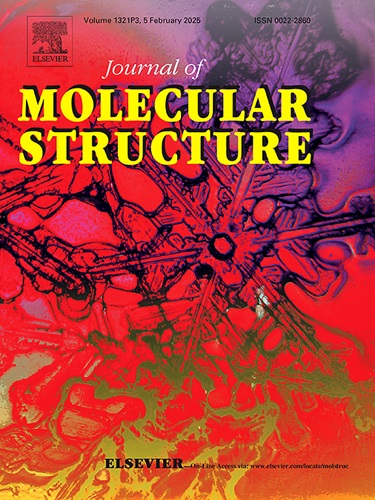MnO2@Polyaniline复合物与牛血清白蛋白相互作用的研究
IF 4
2区 化学
Q2 CHEMISTRY, PHYSICAL
引用次数: 0
摘要
纳米材料(NMs)与蛋白质之间的相互作用对于确定其生物反应性和推进纳米安全性至关重要。纳米复合材料(NCs)在许多应用中取得了显著进展;由于缺乏对其生物分子相互作用的广泛研究,限制了其生物学适用性。在这项研究中,我们首次利用光谱技术,包括紫外-可见吸收、荧光和圆二色性,探索了α-MnO2/聚苯胺(α-MnO2/PANI) NCs与血清白蛋白的分子相互作用。荧光猝灭分析表明,结合常数和结合协同性取决于聚苯胺在nc中的百分比。值得注意的是,聚苯胺含量较高的nc与蛋白质的相互作用降低。重要的是,正如圆二色性和酶活性测定所证实的那样,蛋白质的结构完整性在相互作用后得到了保留,这表明活性只有轻微的降低。这些发现强调了α-MnO2/PANI NCs作为生物相容性材料的潜力,并为其在生物医学应用中的调整提供了基础。本文章由计算机程序翻译,如有差异,请以英文原文为准。

Insight into the interaction of MnO2@Polyaniline composite with bovine serum albumin
The interactions between nanomaterials (NMs) and proteins are pivotal in defining their bioreactivity and advancing crucial progress in nanosafety. Nanocomposites (NCs) have achieved notable progress in numerous applications; the lack of extensive research into their biomolecular interactions has limited their biological applicability. In this study, for the first time, we explored the molecular interactions of α-MnO2/Polyaniline (α-MnO2/PANI) NCs with serum albumin protein using spectroscopic techniques, including UV–Vis absorption, fluorescence, and circular dichroism. Fluorescence quenching analysis revealed that association constant and binding cooperativity depend on the percentage of PANI in the NCs. Notably, NCs with higher PANI content exhibited reduced interaction with the protein. Importantly, the structural integrity of the protein was preserved post-interaction, as confirmed by circular dichroism and enzymatic activity assays, which revealed only a slight reduction in activity. These findings underscore the potential of α-MnO2/PANI NCs as biocompatible materials and provide a foundation for their tuning in biomedical applications.
求助全文
通过发布文献求助,成功后即可免费获取论文全文。
去求助
来源期刊

Journal of Molecular Structure
化学-物理化学
CiteScore
7.10
自引率
15.80%
发文量
2384
审稿时长
45 days
期刊介绍:
The Journal of Molecular Structure is dedicated to the publication of full-length articles and review papers, providing important new structural information on all types of chemical species including:
• Stable and unstable molecules in all types of environments (vapour, molecular beam, liquid, solution, liquid crystal, solid state, matrix-isolated, surface-absorbed etc.)
• Chemical intermediates
• Molecules in excited states
• Biological molecules
• Polymers.
The methods used may include any combination of spectroscopic and non-spectroscopic techniques, for example:
• Infrared spectroscopy (mid, far, near)
• Raman spectroscopy and non-linear Raman methods (CARS, etc.)
• Electronic absorption spectroscopy
• Optical rotatory dispersion and circular dichroism
• Fluorescence and phosphorescence techniques
• Electron spectroscopies (PES, XPS), EXAFS, etc.
• Microwave spectroscopy
• Electron diffraction
• NMR and ESR spectroscopies
• Mössbauer spectroscopy
• X-ray crystallography
• Charge Density Analyses
• Computational Studies (supplementing experimental methods)
We encourage publications combining theoretical and experimental approaches. The structural insights gained by the studies should be correlated with the properties, activity and/ or reactivity of the molecule under investigation and the relevance of this molecule and its implications should be discussed.
 求助内容:
求助内容: 应助结果提醒方式:
应助结果提醒方式:


